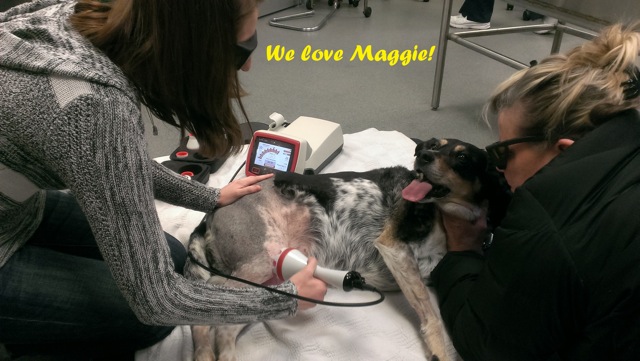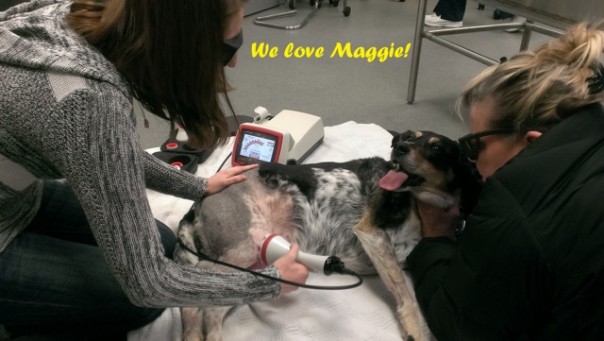
By: Tasha McNerney BS, CVT
Recently I had the privilege of running the anesthesia on my friend/coworker’s dog, Maggie, undergoing surgery to repair an ACL tear. The anesthesia itself was uneventful and – dare I say it? – even boring.
(Side note 1: It’s a good thing when the anesthetic event is boring; that means no complications to get your heart racing!)
(Side note 2: I’m allowed to say it was boring after the fact, and if you were in that room for 5 hours staring at that perfect ECG, you might say the same thing too)
The epidural even went in so beautifully I joked about taking pictures for a textbook I’m putting together. Everything about this case was textbook: from the induction, epidural, intra-op monitoring parameters to the smooth recovery from anesthesia. I figured everything was going to go smoothly in this case, including the recovery period, so we set Maggie up for the usual post op analgesic regime that every ACL repair gets (fentanyl patch and tramadol tablets). I thought I wouldn’t hear much from Maggie and her owner.
And that’s when Maggie reminded us that not every patient reads the pain management handbook and some people’s (or dog’s, in this case) pain tolerance is different than others.
[tweetthis]Maggie reminded us not every patient reads the pain management handbook -[/tweetthis]
Maggie’s owner called me 48 hours after her procedure and said that Maggie seemed to be in a lot of pain, not wanting to get up from sitting, and toe touching on the rear leg. I knew the fentanyl patch had been in place for about 72 hours at that point, so it should have still been in her system. Also, she was on tramadol, so that seems to be a pretty good combination, right? Unfortunately, while we were effectively using an opioid analgesic (the fentanyl, which is related to morphine), there were other ways the body experiences pain (pain pathways) that were NOT being treated in Maggie, and we had to re-evaluate our usual plan.
Taking the Power Ranger Approach to Pain and Healing
We had Maggie come back over to the clinic to start low level laser therapy every other day. Low-level laser therapy is an alternative method of treatment where the injured body part is exposed to lasers of low intensity, which stimulate the cells and tissues and quicken the healing process.
The increased blood circulation to the area also quickens the healing process. We also put Maggie back on her previous doses of carprofen (a non-steroidal anti-inflammatory or “NSAID”) to help with the inflammation. I asked Maggie’s owner how she felt about the tramadol and fentanyl combination and she replied that Maggie had used tramadol in the past for stiffness and it had appeared to be ineffective. So, we took the tramadol away and added in a medication called gabapentin.
The beauty of gabapentin is that it works on the neuropathic aspect of pain (i.e. “nerve pain”). It also works beautifully together with NSAIDs. Gabapentin helps to control nerve pain, thus helping to prevent the “wind-up phenomenon” that can lead to chronic maladaptive pain. Often patients develop chronic pain conditions as a result of ineffective pain management therapy in the post op period.
So, we took Maggie’s previous pain management plan, which was only covering one or two of the ways she might be experiencing pain and expanded her analgesic plan to cover three different pain pathways.
I like to think of the analgesic plan and the therapies as Power Rangers. One Power Ranger battling one pain pathway is usually not enough to control the pain monster, however multiple Power Rangers can work together and combine their powers (pathways) to totally defeat that pain monster.
[tweetthis]Taking the Power Ranger Approach to Pain and Healing -[/tweetthis]
Maggie’s owner called me the next day (only 24 hours later) to say she was noticing a huge improvement. She was now trying to keep Maggie from jumping up on the bed and zooming around the house when the mailman visited. Just tweaking her pain management protocol resulted in a dramatic difference in the quality of her recovery.
Often as with many other facets of veterinary medicine, we find ourselves relying on a “cookbook” approach to post-operative pain management. We get so used to every patient doing “just fine” with carprofen and tramadol that we often don’t look to see what works best for each patient as an individual. So, take the time to follow up with your patients. If that pain management plan isn’t defeating the pain monster, re-assess and start a new plan. Your patients will bounce back faster and your clients will know you truly care about the health and comfort of your pet.
And, if you are a pet owner: trust your instinct. If your pet seems unusually uncomfortable, talk to your veterinarian. Together you can come up with a pain management plan that gets your best friend back in action sooner.
[tweetthis]If you are a pet owner: trust your instinct #painmanagement[/tweetthis]
**Hopkins, J. T., McLoda, T. A., Seegmiller, J. G., & David Baxter, G. (2004). Low-Level Laser Therapy Facilitates Superficial Wound Healing in Humans: A Triple-Blind, Sham-Controlled Study. Journal of Athletic Training, 39(3), 223–229.
· If you would like to find a pet pain specialist in your area, or learn more about preventing animal pain, check out the International Veterinary Academy of Pain Management at www.ivapm.org
· If you want to hear and see more from Tasha McNerney BS, CVT check out her video series on veterinary technician career development for Firstline magazine called “Coffee on the Couch”. Each episode Tasha interviews technicians in different career fields and explores the secrets of their success. Check out the first episode here: http://veterinaryteam.dvm360.com/coffee-couch-conversation-with-veterinary-technician-mary-berg
About Tasha McNerney BS, CVT
Tasha McNerney attended Michigan State University and obtained a bachelor’s of science in 2002 majoring in wildlife biology. After graduation she worked in the field of wildlife rehabilitation in the Florida Keys working with shore birds specifically.
In 2003 Tasha moved to the Philadelphia area and began her veterinary technician training at Manor College in Jenkintown, PA.
Tasha has worked at Rau Animal Hospital in Glenside, PA for ten years as an O.R. / Anesthesia technician. Her areas of interest include sighthound and brachycephalic anesthesia as well as pain management. Tasha has been a featured speaker on various anesthesia and pain management topics at conferences such Atlantic Coast Veterinary Conference, Wild West Veterinary Conference and the American Veterinary Medical Association. Tasha has authored several articles for the NAVTA journal, Firstline magazine, and “Fetch” a blog dedicated to pet parents. Tasha was also a contributing author for the new “Pain Management for Veterinary Technicians” textbook. Tasha is currently working on obtaining her CVPP and VTS (Anesthesia)
In 2013 Tasha created the Facebook group Veterinary Anesthesia Nerds, which has over 4,000 members participating in education and exchange of ideas in all aspects of veterinary anesthesia and pain management.
